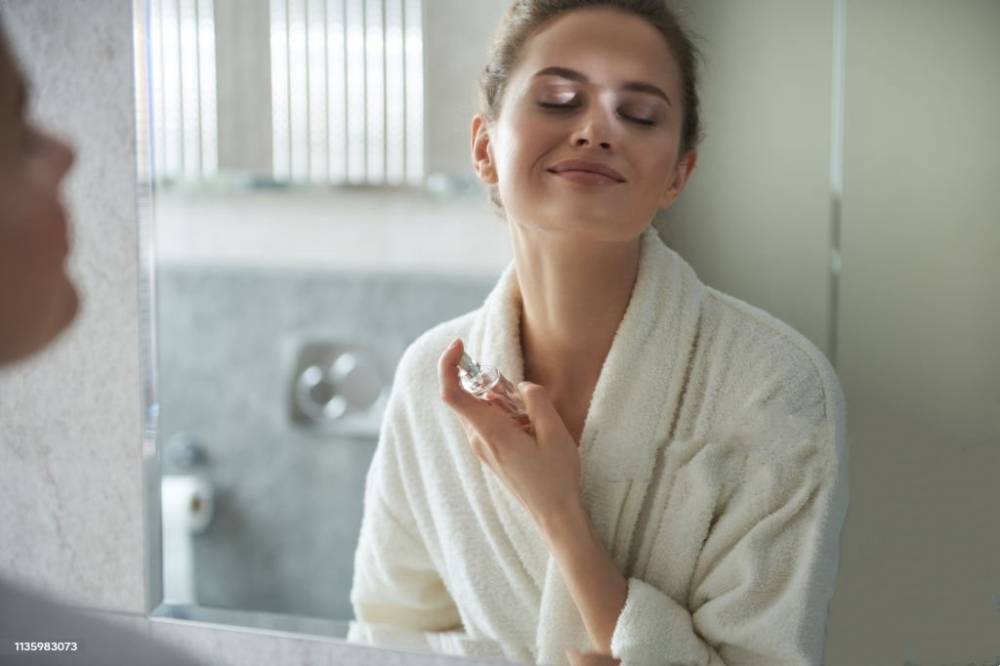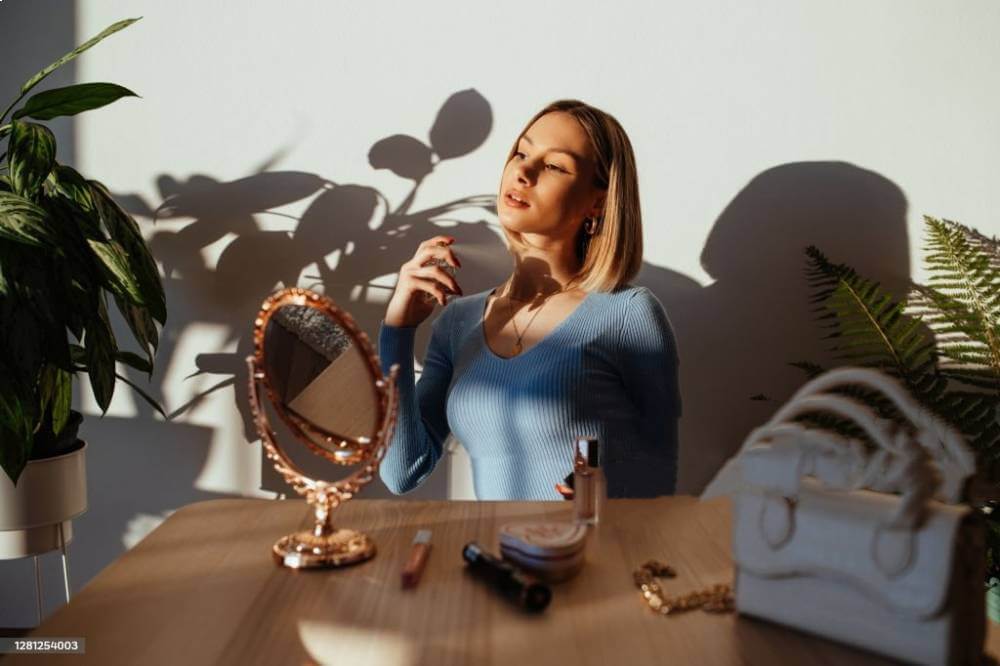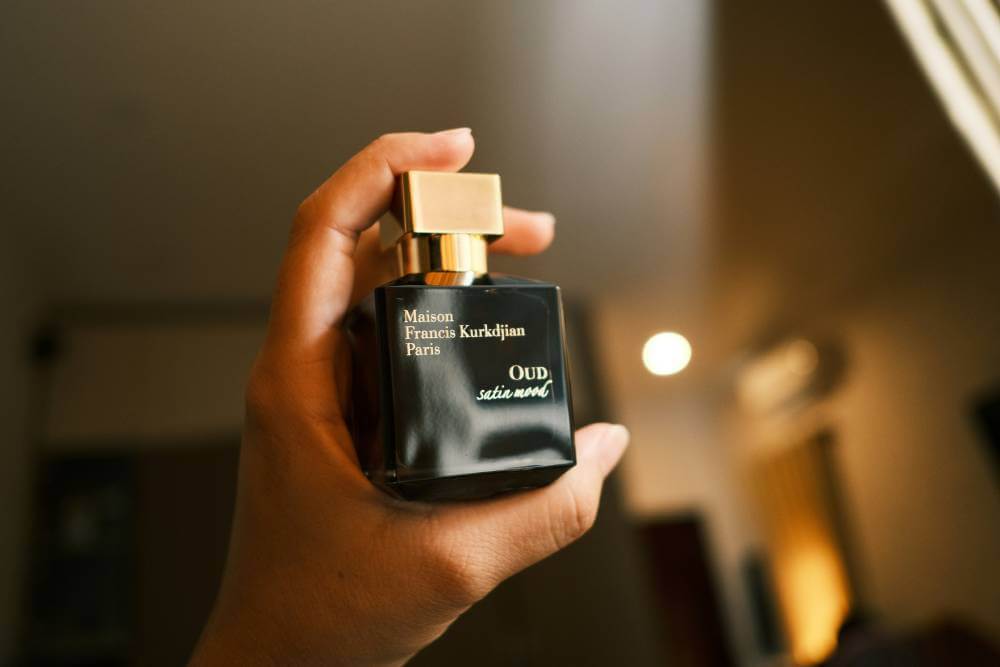Ylang-ylang is a star-shaped yellow flower with big curved petals that grows on the tropical tree Cananga odorata in the rainforests of various Asian countries, Polynesia, and Madagascar. The name Ylang-ylang comes from the Tagalog word ilang, which means wilderness. Some say this name is because the flowers hang and sway in the wind. The blooms grow in clusters of 4 to 12 on the branches of the fragrant tropical Cananga tree, which can grow up to 40 meters (131 feet) tall. Each flower has 2 sets of 3 petals that start green and turn yellow as they mature.
This oil is called the Queen of Perfumes because of its exotic, deep and rich scent. For centuries, it has been used for its therapeutic properties and has been a base note in some of the world’s most famous perfumes, including Chanel No. 5. In this classic scent, Ylang-ylang is an aldehyde, bridging the aldehydic top notes with the floral heart notes of dreamy, musky rose and intense, haunting jasmine.
Today, ylang-ylang is still a popular ingredient among many of the world’s top perfumers. Not much is known about the origin of this beautiful flower, but some botanists think the ancient Polynesian civilization spread it during its early settlement years. Others believe it was popularized during the early days of European colonialism.
We know for sure the French introduced commercial cultivation of Ylang-ylang to the islands of the Indian Ocean in the late 18th century.
What Does Ylang-ylang Smell Like?
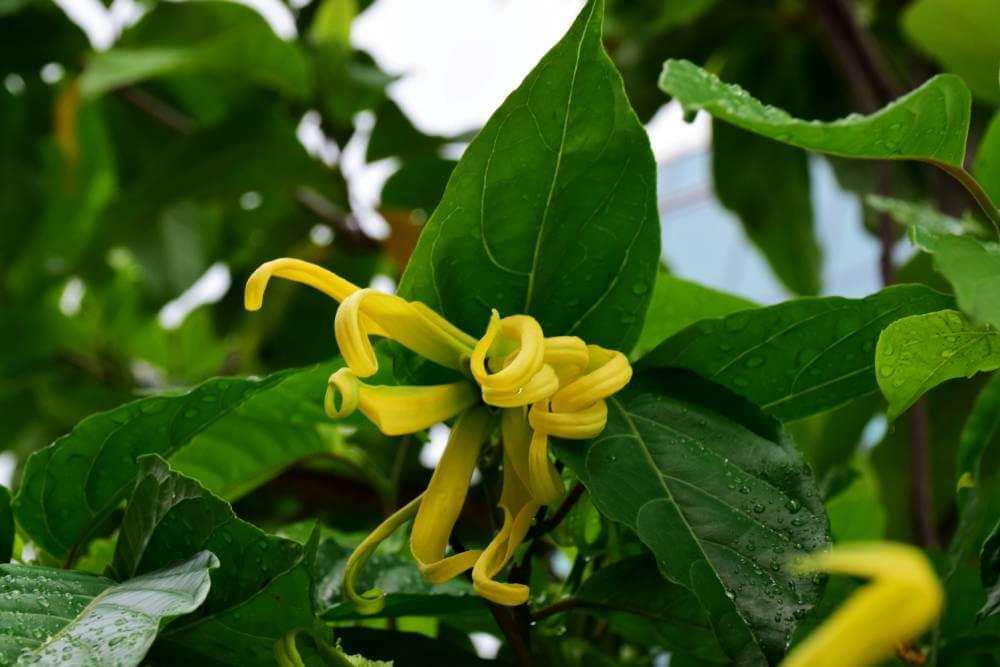
Ylang-ylang’s scent has a unique and powerful aroma that is dreamy and romantic with floral notes that are creamy, balsamic and powdery custard. It has intoxicating jasmine, sweet and slightly pungent banana, light and bitter neroli and sensual, sugary honey. This complex bouquet is alluring and multi-faceted, which is why ylang-ylang’s scent is a favorite in the perfumery world.
Ylang-ylang blends well with other fragrances, and its green richness is unique to this flower. The scent of the flower is often described as exotic and lush, and it evokes images of tropical landscapes and warm evenings. That’s why it’s a staple in many high-end fragrances.
Several chemical compounds contribute to the character of Ylang-ylang. The most prominent of which is linalool, a natural alcohol that is fresh and floral. Linalool is known for its calming properties and is used in aromatherapy to reduce stress. So, Ylang-ylang is not only a nice scent but also a therapeutic one.
Besides linalool, Ylang-ylang has other compounds like geraniol and benzyl acetate that enhance its floral and fruity notes. Geraniol adds a rosy, sweet scent, while benzyl acetate adds a delicate, fruity scent like jasmine and peach. Together, these compounds create a balanced fragrance that’s uplifting and soothing.
Ylang-ylang is mostly found in feminine products and perfumes where it adds a touch of class and sophistication. Its floral richness makes it a favorite for romantic and sensual fragrances. But it’s also occasionally used in masculine scents where it’s paired with notes like creamy sandalwood and green, musty, balsamic vetiver. That’s why Ylang-ylang is a favorite among perfumers.
Fragrance Notes: Floral, Powdery, Rich
Ylang-ylang’s scent is a symphony of floral, powdery, and rich notes that create a truly exotic fragrance. The floral aspect is romantic and soft, evoking images of tropical blooms and warm breezes. The powdery notes add a warm, gentle touch reminiscent of delicate custard and creamy balsamic undertones. Finally, the rich notes provide depth and complexity, making ylang-ylang a multifaceted fragrance that is both uplifting and soothing. This unique combination of scents is what makes ylang-ylang an iconic fragrance in the world of perfumery.
Ylang-ylang Versatility
Besides perfumes, Ylang-ylang is also used in aromatherapy and natural wellness. Its calming properties make it a favorite in essential oil blends, where it’s used to promote relaxation and emotional balance. Many people find that the scent of Ylang-ylang can help reduce anxiety and stress, so it’s a great addition to meditation or self-care routines.
Ylang-ylang oil is also used in skincare products for its moisturizing and soothing properties. Its ability to hydrate the skin and its pleasant scent makes it a sought-after ingredient in lotions, creams and body oils.
Where does Ylang-ylang Come From?
Ylang-ylang, with its beautiful scent, comes from the tropical regions of Southeast Asia, particularly in the Philippines, Indonesia and Madagascar. The extraction method used to obtain the essential oil from the flower is steam distillation. This method vaporizes the volatile compounds and collects and compresses them to preserve the delicate scent and therapeutic properties of the flower.
The Steam Distillation Process
The steam distilled process involves several stages, each contributing to the final product’s scent profile. The flowers of the Ylang-ylang tree are harvested and then subjected to steam, which releases the essential oils. As the steam passes through the flowers, it carries the volatile compounds with it. When the steam cools down, the oil separates from the water and can be collected.
A grading system classifies the different types of Ylang-ylang, and depending on how it will be used, the extraction will vary in strength. For example, perfume production requires a stronger concentration than cosmetic products, so there are different grades of Ylang-ylang oil.
Grading and Quality
The most potent and expensive form of this essential oil extract is Extra, which has the highest concentration of natural organic compounds like linalool, geranyl acetate and benzyl acetate. This is most commonly found in niche perfumes because of its refined, rich and sophisticated scent.
The grading system:
Extra: The highest quality with a rich and complex scent perfect for niche perfumes.
First: Slightly less potent than Extra but still good for premium fragrances.
Second: A more diluted version is often used in lower-priced perfumes and scented products.
Third: The mildest grade that is used in cosmetic products where a lighter scent is required.
I find it interesting how the grading of Ylang-ylang oil can make a big difference in the scent experience. When I choose a perfume, I look for those that specify the use of Extra Ylang-ylang because I love the depth it adds to the scent profile.
Complete Ylang-ylang Essential Oil
Ten to twenty hours of continuous distillation produces an essential oil called Full, which is a combination of all four stages of distillation. This variety has the highest amount of redolent facets like beta-caryophyllene (BCP) and germacrene, which gives deep, floral and fruity notes to any fragrance with Ylang-ylang. The Full oil is often used in aromatherapy and natural wellness products because it captures the full profile of the flower.
The Cultural Significance of Ylang-ylang
Ylang-ylang has cultural significance in many places where it is grown. In the Philippines, for example, flowers are used in traditional rituals and celebrations. The scent is believed to be calming and uplifting, so it’s often used to create a peaceful ambiance.
I like that Ylang-ylang is not just a scent but also a part of cultural practices. It’s interesting to think about how one flower can carry so much meaning and history across cultures.
Besides perfumery and aromatherapy, Ylang-ylang is also used in culinary applications in some cultures. The flowers can be infused into teas or used as a flavoring agent in various dishes to show how versatile this plant is.
Ylang Ylang Benefits
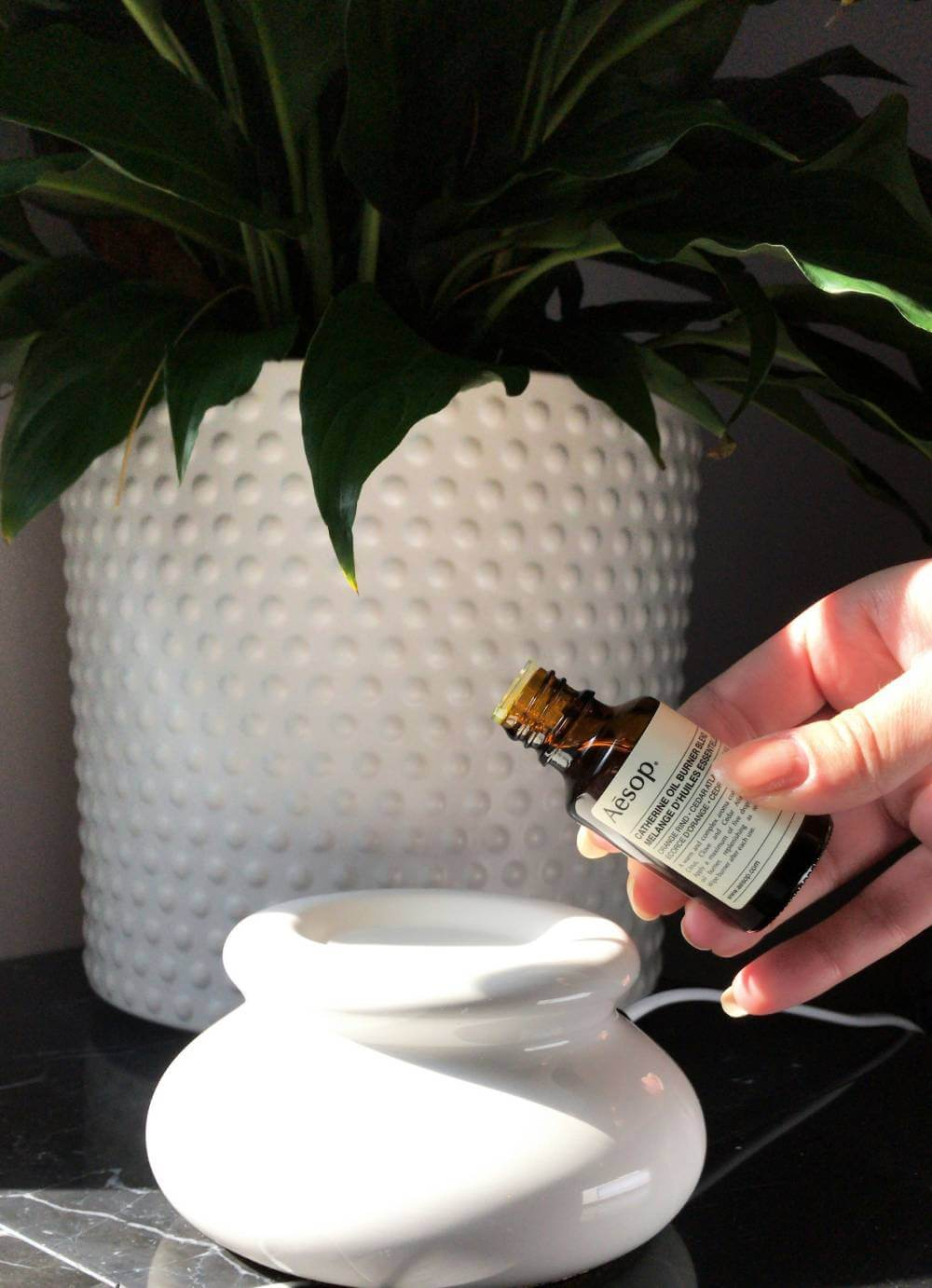
Ylang-ylang is not just an iconic scent; it has been used in aromatherapy for centuries to alleviate symptoms of stress and anxiety. Its calming nature is said to promote a positive mindset and reduce anger, so it’s a favorite among those who want emotional balance.
Aromatherapy and Emotional Well-being
The calming nature of ylang-ylang makes it a great addition to aromatherapy. Many people find that diffusing ylang-ylang oil in their homes creates a peaceful ambiance that promotes relaxation and calmness.
Cognitive Benefits
Ylang-ylang is also used to improve memory and thinking. Its uplifting scent can stimulate the mind and enhance cognitive function, so it’s a great tool for those who want to boost their mental clarity.
Aphrodisiac Properties
Besides cognitive benefits, ylang-ylang is also an aphrodisiac. In Indonesian culture, the flowers are often sprinkled in the beds of newly wedded couples, symbolizing love and intimacy. The sweet, exotic scent is believed to increase romantic feelings and create a sensual atmosphere.
Physical Health Benefits
A 2013 Korean study with 52 participants found that ylang-ylang reduced blood pressure. This is a natural remedy for those who have hypertension or stress-related health issues.
Skin Care Applications
Ylang-ylang is also used in some skin care products because it normalizes the secretion of sebum—the fatty lubricant matter secreted by sebaceous glands of the skin. This is good for those with oily or combination skin to balance oil production and have a healthy complexion.
Some Of Our Recent Compositions Featuring Ylang Ylang
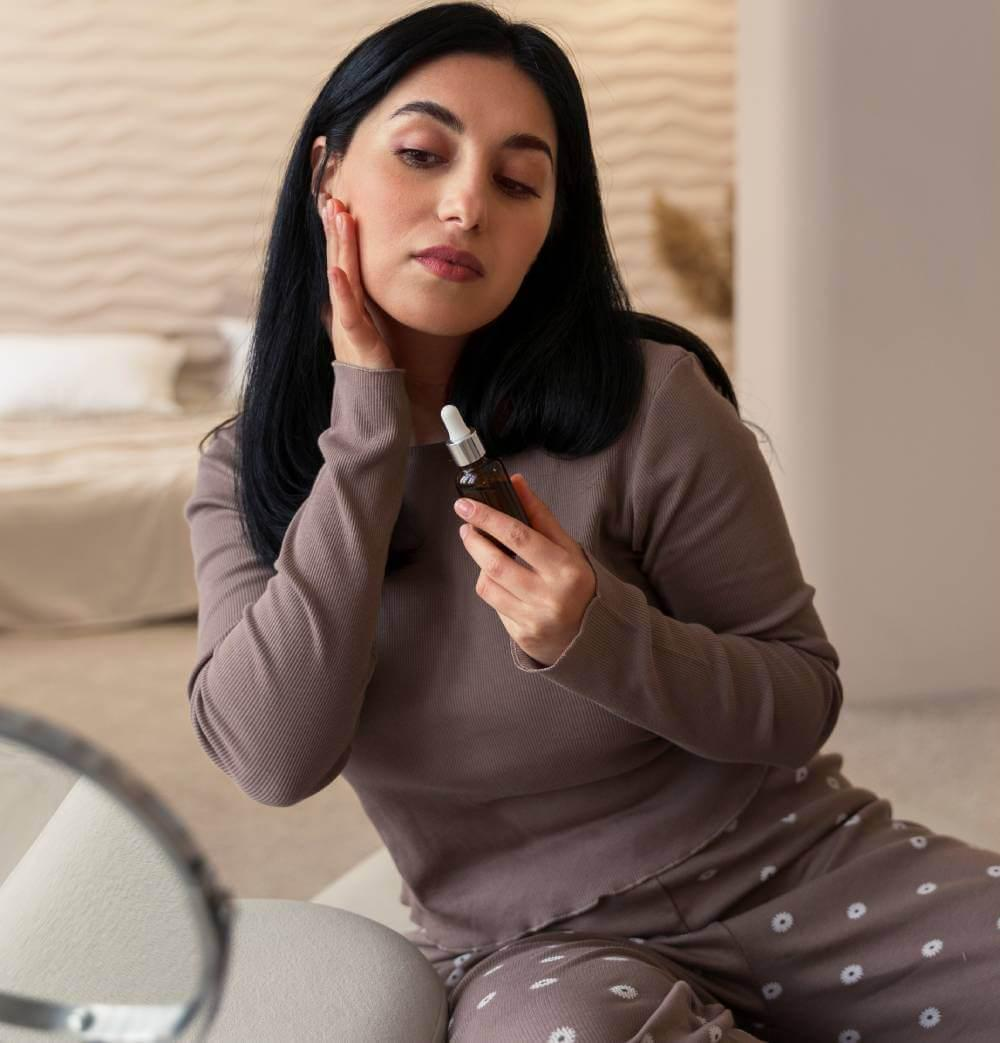
Whether for personal care products, candles, reed diffusers, home fragrances, odor neutralizers, industrial air fresheners, private label brands, household cleaning products and last but not least fine customized perfumes, our master perfumers are always creating new scents for clients from around the world.
Ylang-ylang’s unique scent makes it a versatile ingredient that can be used in many products, including some of the world’s most beloved fragrances. Below are some of those fragrances that feature ylang-ylang.
Dirty Fragrances—Peppercorn Jasmine
Peppercorn Jasmine is a stimulating fragrance that will grab your senses with its unique blend. This scent starts with a top note that has facets of citrus sparkle, perfectly complemented by the narcotic, sensual and sweet scent of ylang-ylang. The combination is uplifting and energizing and will draw you in immediately.
As the fragrance develops, the top notes fold into a floral heart note bouquet. Here the rich and honeyed scent of jasmine sambac takes center stage, sweet and alluring. The floral richness is balanced by the earthy, balsamic and musty notes of vetiver that add depth to the composition.
The dry down of Peppercorn Jasmine is where the fragrance really kicks in. Sharp, spicy and rosy peppercorn notes blend with warm, woody and dry cedar wood to complete this sensual perfume. The combination of these notes will leave a lasting impression on the skin.
When I wear Peppercorn Jasmine, I like to layer it with a light body lotion that has similar floral notes. This will enhance the fragrance, make it last longer throughout the day, and create a cohesive scent experience.
Amber Fragrances—Wild Saffron and Amber
Wild Saffron and Amber is an unforgettable fragrance that will grab your senses with its complex blend. This scent starts with head notes of zesty, fruity and green rhubarb that will give you a refreshing and lively introduction. The piquant lime will add zing, and the bittersweet, intimate and leathery saffron will set the stage for the fragrance to unfold.
As the fragrance develops a middle note follows with a floral bouquet of rosy geranium and rich ylang-ylang. The soothing, sweet-smelling lavender will add a calming touch, and the powdery violet will add a soft, delicate nuance. Deeply sensual and intoxicating jasmine will complete this floral heart and create a lush and seductive experience.
The dry down of Wild Saffron and Amber is where the fragrance really shows its face. Earthy, erotic musk will add a warm and intimate feel. Green, balsamic vetiver will provide an earthy base, and musky, potent patchouli will add a rich, grounding element. Warm, rich and honeyed amber will complete this seductive perfume and wrap the wearer in luxury.
I like to wear Wild Saffron and Amber in the evening or for special occasions. The combination of floral and earthy notes will create a sophisticated vibe that’s both elegant and alluring. It’s a fragrance that makes a statement without being too much.
Facial Skin Products—Blue Agave and Sea Salt
Blue Agave and Sea Salt is a sea-inspired fragrance that will grab your senses with its fresh and uplifting blend. This scent starts with sweet and juicy facets of mild, sugary casaba melon. The fuzzy, fatty notes of the apricot kernel will add a creamy texture, and the ozonic marine sea salt will give a crisp, airy feeling like ocean air.
As the fragrance develops, these notes will drift into a heart note with jasmine nuanced, floral ylang-ylang. This luxurious floral note is beautifully paired with a musky, romantic rose that will add depth and warmth. Earthy, green moss will add a grounding element, and hot, spicy clove will add a touch of warmth and complexity. The mellow, smooth and sweet blue agave will complete the heart and create a balanced blend that’s both refreshing and comforting.
The dry down of Blue Agave and Sea Salt is where the fragrance really shows its face. A warm base of earthy musk will wrap the wearer, and velvety sandalwood will add a soft, creamy touch. Slightly sweet nectar will finish this scent and leave a lingering sweetness that’s both inviting and alluring.
I like to wear Blue Agave and Sea Salt in the daytime, especially during the summer. The fresh, oceanic notes will calm and relax you, perfect for beach or casual occasions.
Ozonic Fragrances—Black Amber Musk
Black Amber Musk is a scent that starts with head notes of complex, green and fruity bergamot. The bright and fresh bergamot will introduce the fragrance. The lush mandarin will add a sweet touch, and the sharp, black currant will add a bold, tangy feel that will wake up your senses.
As the fragrance develops, these top notes will fade into a heart note bouquet with haunting, exotic jasmine. This floral note is paired with narcotic, rich and sweet ylang-ylang that will add sensuality. The heart is further enriched with rich, creamy gardenia and vanilla-tinged, powdery orchids to create a lush and luxurious floral experience.
The dry down of Black Amber Musk is where the fragrance truly reveals its complexity. It is marked by aspects of dark, honey-tinged amber, which adds warmth and richness. Warm sandalwood provides a creamy, soft base, while passionate, erotic musk introduces an intimate and alluring quality. Earthy patchouli adds depth and earthiness, and lush, noble vanilla finishes this memorable fragrance with a sweet, comforting touch.

